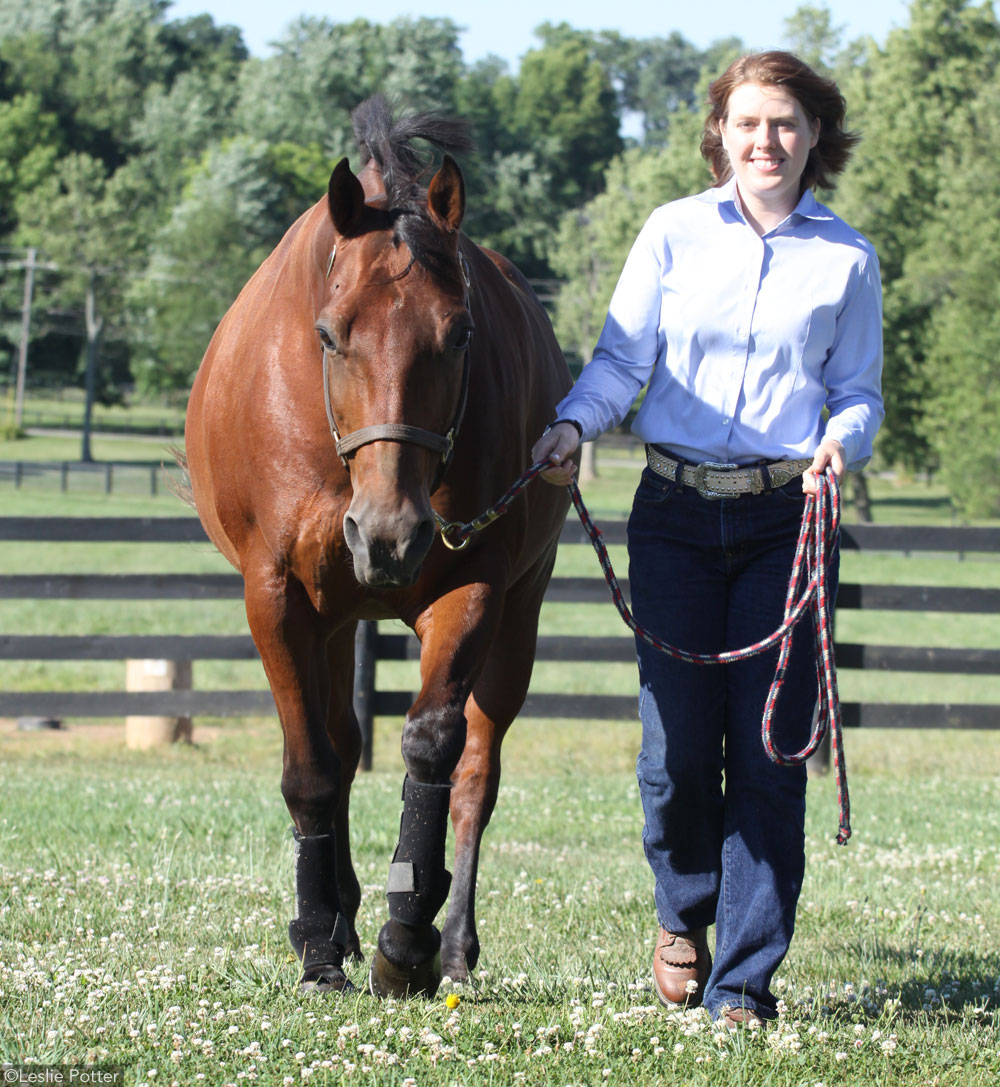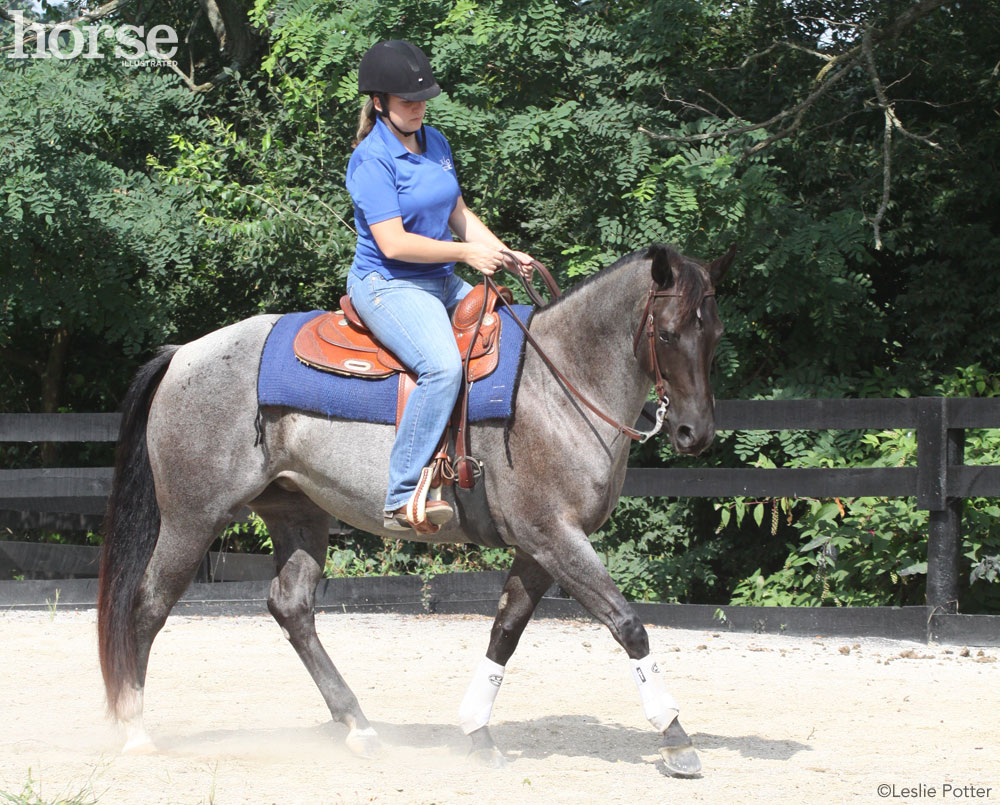When your horse doesn’t have a proper halt, safety is a concern. Although your horse’s stop may not seem like a gear that needs tuning up, you do have to regularly inspect your brakes.
Letting your horse get lazy with his stops allows him to ingrain this negative behavior. “It’s like a little kid who wants a cookie,” says Bourbannais. “He keeps inching closer and closer to the cookie jar, and you do nothing to stop it. When he finally grabs the cookie and you confront him, it’s too late. You need to nip it in the bud way earlier.”
Stop, Drop and Whoa
Bourbannais explains that a good whoa means the horse stops by dropping his hind end while maintaining forward impulsion.
Before starting any training drills, however, she advises that you thoroughly inspect your horse for any ailments or lameness that may be preventing him from performing a good stop. Have the vet check his teeth for sharp edges; check his neck, poll and body for stiffness; his gait for free movement; and his back for good muscling.
Ground Work
As with any skill, the best way to work on a whoa is from the ground up. Try some of these exercises:
1. Walk it out
Lead your horse, keeping his throatlatch even with your shoulder. When you’re ready to stop, tell your horse “whoa” first. Then suck your body back slightly, putting your weight into your heels to give him a visual cue. If he doesn’t stop, bump on the halter and immediately turn and face him, and ask again for a halt. You may ask for a small step back to reinforce the stop, but don’t do this every time. Bourbannais says the key to this exercise is being consistent and using firm, crisp movements to keep your horse’s attention.

If your horse is meeting you with resistance or blowing past you in this drill, be sure to ask more sternly. But always ask softly each time you repeat the drill. Instead of using a crop or stick, Bourbannais suggests using the end of the lead rope to snap the horse on the chest if necessary. She says simply making a quicker, bigger motion toward your horse can help reinforce your cues, as long as your timing is correct.
2.Practice other maneuvers
Ask for some turns on the forehand and hindquarters to get your horse focused on you. Practice downward transitions, using cones or fence posts as markers. At a trot, get your horse to match your rhythm and stride so you can slow or stop together. Be sure to give your horse time to process what he is learning after each stop. Switching up exercises will help your horse tune in to you.
3. Ground work in the round pen
Consistency is key here. Ground work in the round pen will reinforce cues you have taught your horse in-hand.
If you’re having trouble, Bourbannais says be sure your body language is giving off the right tone. “Many handlers ask their horse, ‘Whoa?’” she says. “Don’t end your statement with a question. Whoa is whoa.”
Under-Saddle Work
Once your horse is consistently stopping during groundwork, you can saddle up. When you are riding and you want a whoa, say “whoa,” sit back, sit deep, close your knees on the horse with your lower ankle off, pull back slightly on the reins with even pressure until contact is made with your horse’s mouth, and hold for the stop.
Reward a stop with a loose rein and time to relax. Your next goal is to teach the horse to respond to your weight in the saddle. Practice some of the following exercises at home.
1. Don’t start with a stop
Start your ride by letting your horse move out and free up his gait. He should have good forward movement before you ask for a stop. When you do ask, quit riding and sit deep in the saddle so your horse can begin to feel the difference in your body language.
2. Change it up
“When working on a whoa, I change directions after I stop,” says Bourbannais. “It helps disengage the horse and gets him to shift his weight back.” Riders often use backing as negative reinforcement when the horse fails to stop crisply, so Bourbannais suggests using direction changes instead.
3. Give your horse a job
Patterns are great exercises for the rider and horse because it gives you both a job. Focus on your body position and consistency when asking for a whoa. Repeat your transition a few times in a row so your horse can comprehend the exercise, and allow him time to stand and process what you are teaching. You should also practice precise placement of your stop, whether that is stopping with the horse’s nose, hip or shoulder to cone, or your leg even with the cone. Make sure you give your horse enough time to respond, though. Don’t wait until you are on top of the cone to ask for a stop.

4. Try something new
A fun way for your horse to practice natural stopping reactions is to have him work cattle. Bourbannais says the sport excites horses because it gives them a purpose for all the foundation exercises they train through. If you’re not comfortable being around cattle, start with a partner-mirroring activity. Have one partner and her horse be the cow. Follow the partner pair, stop when they stop, and back a step and rollback when they change directions. Then mirror them along the other direction. The horse will be intrigued by having something to follow.
Troubleshooting saddle work:
“People don’t want to hear it, but a lot of the time [a bad whoa is] rider error,” Bourbannais says. “They’re not sitting, they’re pulling too hard, and their spur is in their horse giving a forward cue at the same time they are pulling on the horse’s face.”
A good way to check yourself is to have someone video your ride. Pay attention to when you ask for a whoa verbally and how you ask with your seat, legs, hands and timing. If your balance is an issue, work on developing your seat by having someone longe you. You can also practice cues and timing by riding a “schoolmaster” horse.
Make the firm decision to stop letting your horse walk all over you. Stop denying that you might be the problem. Ask for help if you need it. And start getting a great whoa!
A freelance writer from Woodstock, Ill., LISA KUCHARSKI enjoys recreational trail riding and competing in open shows.
This article originally appeared in the January 2016 issue of Horse Illustrated magazine. Click here to subscribe!





